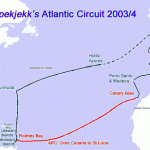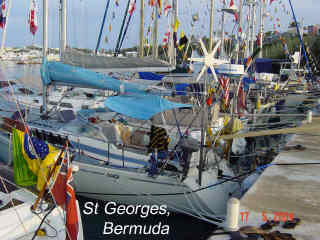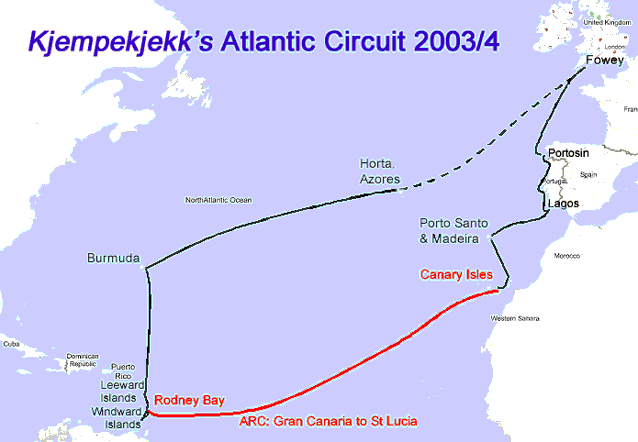
Early summer 2005 and I’ve spent a lazy day pottering around on our Maxi 33 ‘Kjempekjekk’. Just two years ago Liz and I had been doing much the same sort of thing, completing preparations for some extended sailing and we were almost ready to go. Although we’d signed up for the Atlantic Rally for Cruisers (ARC) we still harboured the thought that in due course we might prefer to head towards the Mediterranean. Then our son Mike phoned to tell us that he’d just booked flights to St. Lucia for himself and partner Hannah and they would see us there at Christmas!
and we were almost ready to go. Although we’d signed up for the Atlantic Rally for Cruisers (ARC) we still harboured the thought that in due course we might prefer to head towards the Mediterranean. Then our son Mike phoned to tell us that he’d just booked flights to St. Lucia for himself and partner Hannah and they would see us there at Christmas!
 and we were almost ready to go. Although we’d signed up for the Atlantic Rally for Cruisers (ARC) we still harboured the thought that in due course we might prefer to head towards the Mediterranean. Then our son Mike phoned to tell us that he’d just booked flights to St. Lucia for himself and partner Hannah and they would see us there at Christmas!
and we were almost ready to go. Although we’d signed up for the Atlantic Rally for Cruisers (ARC) we still harboured the thought that in due course we might prefer to head towards the Mediterranean. Then our son Mike phoned to tell us that he’d just booked flights to St. Lucia for himself and partner Hannah and they would see us there at Christmas!August 5th 2003 was a bright and blustery day and we left to a wonderful send-off from family and friends; within an hour we were overtaken by a black thunderstorm and with lightning striking the sea no more than 25 metres from KJ’s starboard quarter we wondered what other new experiences our journey would bring!
This first leg of our voyage took us across Biscay to the Rias of NW Spain. We decided to get south of Finisterre in 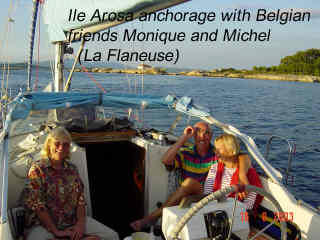 one
one
 one
onehop and five days later, having narrowly missed a large whale and undergone a night-time invasion by a swarm of moths, we made a dawn landfall off Ria Muros, Galicia. Berthing at Portosin marina was easy, the staff were friendly and the facilities very good. We soon found out that the top floor of the local library was fitted out with a dozen internet terminals and the service was free, including on-hand expert help. The town is a short walk from the marina and we used the local bus service to visit Santiago de Compostella; services were clean, punctual and reasonably priced.
After a few days we continued slowly southwards to Ria Arosa. We stayed 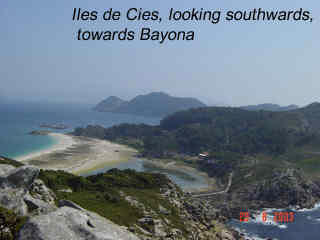 several days here at a lovely anchorage on the NW side of Ile Arosa, in 4 metres just off a quiet beach and a short walk from the small town of St Julien. Our visit coincided with a local festival; sardines straight off local boats and onto beachside grills, fresh-baked bread and good wine. We loved it.
several days here at a lovely anchorage on the NW side of Ile Arosa, in 4 metres just off a quiet beach and a short walk from the small town of St Julien. Our visit coincided with a local festival; sardines straight off local boats and onto beachside grills, fresh-baked bread and good wine. We loved it.
 several days here at a lovely anchorage on the NW side of Ile Arosa, in 4 metres just off a quiet beach and a short walk from the small town of St Julien. Our visit coincided with a local festival; sardines straight off local boats and onto beachside grills, fresh-baked bread and good wine. We loved it.
several days here at a lovely anchorage on the NW side of Ile Arosa, in 4 metres just off a quiet beach and a short walk from the small town of St Julien. Our visit coincided with a local festival; sardines straight off local boats and onto beachside grills, fresh-baked bread and good wine. We loved it. Ria Pontevedra was our next stop and a breezy anchorage off the quaint but touristy village of Cambarro. Excellent holding here and when we left it took quite an effort to get our anchor out of the sticky grey mud. Sailing down to the Iles de Cies we encountering thick fog for most of the way, but GPS and radar enhanced our confidence and by the time we anchored conditions had cleared. It was very windy in the anchorage off the east coast so the following morning we went around to the south side and anchored close in to an excellent secluded beach; this was much better. We enjoyed Cies; ferries bring day trippers from the mainland but there are good walks, lovely views and safe swimming.
Bayona was just a few hours sail to the SSE of Cies and we arrived in good, sunny weather. We took a bow-to berth in the excellent marina; facilities were good and the smart yacht club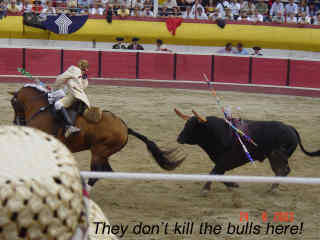 was very welcoming. The town was pleasant with a good beach, reasonable prices and an ambience not at all like the Costas in the south; we liked it! After a few days we continued southwards towards the coast of Portugal and the Algarve. At Viana de Costello, the first town on the northern border, it was fiesta time and crowded. There were all sorts of markets, parades, bullfights, and magnificent fireworks to round it all off.
was very welcoming. The town was pleasant with a good beach, reasonable prices and an ambience not at all like the Costas in the south; we liked it! After a few days we continued southwards towards the coast of Portugal and the Algarve. At Viana de Costello, the first town on the northern border, it was fiesta time and crowded. There were all sorts of markets, parades, bullfights, and magnificent fireworks to round it all off.
 was very welcoming. The town was pleasant with a good beach, reasonable prices and an ambience not at all like the Costas in the south; we liked it! After a few days we continued southwards towards the coast of Portugal and the Algarve. At Viana de Costello, the first town on the northern border, it was fiesta time and crowded. There were all sorts of markets, parades, bullfights, and magnificent fireworks to round it all off.
was very welcoming. The town was pleasant with a good beach, reasonable prices and an ambience not at all like the Costas in the south; we liked it! After a few days we continued southwards towards the coast of Portugal and the Algarve. At Viana de Costello, the first town on the northern border, it was fiesta time and crowded. There were all sorts of markets, parades, bullfights, and magnificent fireworks to round it all off. We then stayed six days at Liexoes, near Porto, while some adverse weather sorted itself out. The marina is in a corner of the commercial dock area and despite the best efforts of the marina staff it seems to attract a lot of floating debris; we found that the centre row of pontoons was not nearly so badly affected. Again, we found that local transport was efficient and clean.
It’s around a hundred miles southwards from Leixoes to Nazare and we arrived in the dark. Armed police suggested that we checked in with them immediately and told us that the marina manager (British) was out for the evening and that we should check in with him in the morning. Bad weather in the night, very heavy rain. Just after 0730 there was a loud banging on our coach-roof and the voice of the marina manager shouting orders that we were to report to him in his office in ten minutes and that we were to re-moor our boat as he didn’t like the way it was done – and he was a Yachtmaster and knew what he was talking about! His approach to yachtsmen appeared to range from occasionally patronising to offensive and we didn’t stay long. 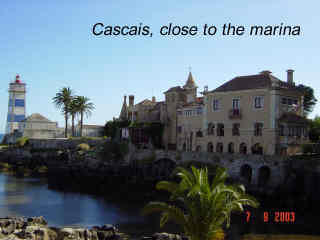 However there is an excellent fuel berth at the north end of the harbour and the port is relatively safe to enter in bad weather. Friends of ours were directed to moor on the fishing boat wall and the following day found a stowaway mouse!
However there is an excellent fuel berth at the north end of the harbour and the port is relatively safe to enter in bad weather. Friends of ours were directed to moor on the fishing boat wall and the following day found a stowaway mouse!
 However there is an excellent fuel berth at the north end of the harbour and the port is relatively safe to enter in bad weather. Friends of ours were directed to moor on the fishing boat wall and the following day found a stowaway mouse!
However there is an excellent fuel berth at the north end of the harbour and the port is relatively safe to enter in bad weather. Friends of ours were directed to moor on the fishing boat wall and the following day found a stowaway mouse!We were pleased to leave Nazare and enjoyed a great sail down past Berlinga and around Cabo Roca to Cascais, just west of Lisbon. In a vigorous breeze, Kjempekjekk sailed fast around the cape, holding around 8 knots through the water until we tacked for the marina entrance. We LIKED it here. It’s a lovely town, with a good beach; there is plenty to explore and many good restaurants. The rail service into Lisbon is excellent and we stayed more than a week until Liz felt the dew on deck one morning and proclaimed that it was time to carry on south.
Sines next, just for a night before continuing round Cape St Vincent. But we liked it here too – another very pleasant town, not too touristy, proper local restaurants with good wine and friendly people. 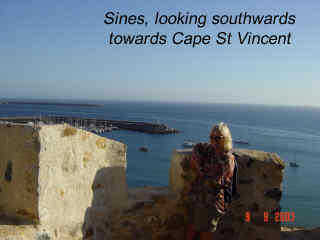 The beach is well looked after – swept every morning and very safe, so we stayed a few more days.
The beach is well looked after – swept every morning and very safe, so we stayed a few more days.
 The beach is well looked after – swept every morning and very safe, so we stayed a few more days.
The beach is well looked after – swept every morning and very safe, so we stayed a few more days. It’s over seventy miles from Sines around to Lagos so we made an early start. By lunchtime the wind had died away completely and we found ourselves donking along under a very large cloud of smoke coming off the land. Later we found the cause was a forest fire in the Monchique hills, inland from the western Algarve. We rounded Cape St Vincent under clear skies but still no wind to speak of. An hour later we had a sudden change of engine sound and vibration; it cleared just as suddenly so we think it was probably our rope cutter doing its job! We checked into Lagos at dusk.
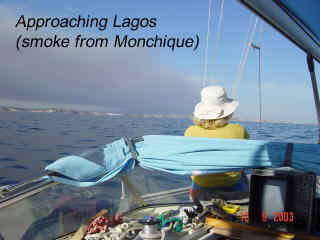 Going east from Lagos a few days later, we looked into Alvor but the anchorage off the town looked overcrowded and the very shallow water and surrounding sandbanks rather intimidating (no chart!), so we continued to Portimao. The marina here is very good. Secure finger berths and just about every facility; but we preferred the anchorage across the river. Good holding, handy for an excellent, uncrowded beach, nobody chasing euros; and wonderful sunsets.
Going east from Lagos a few days later, we looked into Alvor but the anchorage off the town looked overcrowded and the very shallow water and surrounding sandbanks rather intimidating (no chart!), so we continued to Portimao. The marina here is very good. Secure finger berths and just about every facility; but we preferred the anchorage across the river. Good holding, handy for an excellent, uncrowded beach, nobody chasing euros; and wonderful sunsets.A few days later we went back to Lagos for a while to top up before heading out on Sep 20th for the three day passage to Porto Santo. 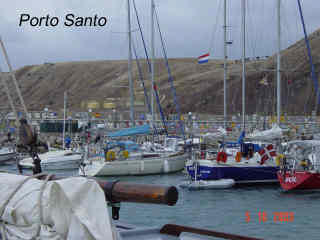

This was yet another short stop that turned into a ten-day holiday! Very limited facilities but the place and the people more than made up for it – and we were there for yet another festival, this time commemorating the departure of Columbus for the New World. Enthusiastic locals encouraged us to join in the occasion and we had a delightful, memorable evening.
We blew down to Madeira on a bright, blustery F7, rounding up into a new (uncharted!) marina, Quinto do Lorde, at the eastern end of the island. Unfinished, so there was plenty of room but temporary showers and heads in small portacabins. There was a friendly bar and restaurant nearby and just up the road a bus stop with a service into Funchal. Times were somewhat limiting however; on a day trip, time in the city was just a couple of hours before the last bus back to QDL. We wanted to see more, so after a few days we headed down the coast to Funchal and managed to get a berth alongside the wall in the crowded marina – an advantage of having a relatively small boat. We enjoyed the metropolitan bustle and the wonderful gardens here and made good use of the local buses to get around the sights. To go further afield we hired a car for a day; well worth it.
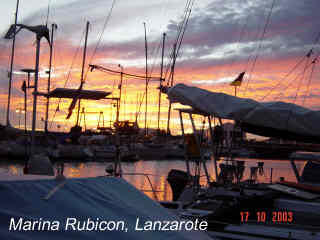 Our departure for Lanzarote was marked by a sky filling with hooked cirrus so we decided to forgo our permit to visit the Salvegen Islands and sail direct. Dolphins escorted us for some of the way and on day three we found our way into the brand new Rubicon Marina at the south end of the island. Excellent facilities here, with good safe beaches and a very pleasant stroll along the coastal path to the restaurants and shops of Playa Blanca.
Our departure for Lanzarote was marked by a sky filling with hooked cirrus so we decided to forgo our permit to visit the Salvegen Islands and sail direct. Dolphins escorted us for some of the way and on day three we found our way into the brand new Rubicon Marina at the south end of the island. Excellent facilities here, with good safe beaches and a very pleasant stroll along the coastal path to the restaurants and shops of Playa Blanca.Too soon it was time to move on and KJ took us southwards once more. One night at Puerto Castillo on the east side of Fuertaventura was all we could take; shower/heads facilities were available but filthy and it proved almost impossible to recover the key deposit (€24) before our departure.
Eventually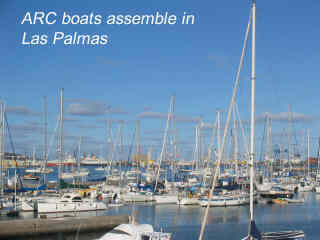 our persistence prevailed and it was returned with a scowl; we sailed fifteen minutes later. Another great sail down the E coast of Fuertaventura and around the southern end; during the evening we used the SSB for the first time to speak to a UK station – quite a triumph after a number of problems with our set so we were quite happy and slowed KJ down to ensure we arrived at Las Palmas in daylight.
our persistence prevailed and it was returned with a scowl; we sailed fifteen minutes later. Another great sail down the E coast of Fuertaventura and around the southern end; during the evening we used the SSB for the first time to speak to a UK station – quite a triumph after a number of problems with our set so we were quite happy and slowed KJ down to ensure we arrived at Las Palmas in daylight.
 our persistence prevailed and it was returned with a scowl; we sailed fifteen minutes later. Another great sail down the E coast of Fuertaventura and around the southern end; during the evening we used the SSB for the first time to speak to a UK station – quite a triumph after a number of problems with our set so we were quite happy and slowed KJ down to ensure we arrived at Las Palmas in daylight.
our persistence prevailed and it was returned with a scowl; we sailed fifteen minutes later. Another great sail down the E coast of Fuertaventura and around the southern end; during the evening we used the SSB for the first time to speak to a UK station – quite a triumph after a number of problems with our set so we were quite happy and slowed KJ down to ensure we arrived at Las Palmas in daylight. Las Palmas in Gran Canaria is where we joined the World Cruising Club`s ARC Rally for the Atlantic crossing to Rodney Bay, St. Lucia. We spent around three weeks here, mending, making, preparing, storing, partying, meeting old friends and making new ones. Great support from the WCC ARC Team and local sailmakers, chandlers, engineers etc, as well as visits from UK/Europe based equipment suppliers. 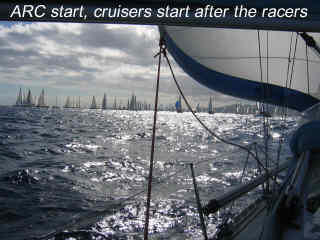 We took up opportunities to attend more
We took up opportunities to attend more
 We took up opportunities to attend more
We took up opportunities to attend morepreparatory seminars, underwent safety checks and of course dropped in on many a happy-hour. We also seem to recall a superb fancy-dress extravaganza and several pontoon parties!
Start day was wonderful, a fantastic atmosphere and good weather. The racing division went off first and twenty minutes later we cruisers headed off – most of us looking very much like we were racing! On the first night out there were lights everywhere; on night two just a few dozen and after that mostly none. Passage plans varied from a rhum line to St Lucia to the traditional waypoint NW of Cape Verdes then west.
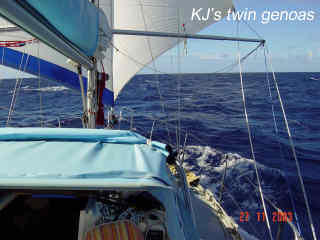 We took the rhum line for a few days until a forecast warning of squalls with potential gusts of 60 to 80 knots persuaded us to make a bit more southing. We still met some squalls but with gusts of around 35/40 knots. However, the trade winds were elusive and we were becalmed for several days in mid Atlantic; it was a great relief when the breeze came back and we could roll on westwards.
We took the rhum line for a few days until a forecast warning of squalls with potential gusts of 60 to 80 knots persuaded us to make a bit more southing. We still met some squalls but with gusts of around 35/40 knots. However, the trade winds were elusive and we were becalmed for several days in mid Atlantic; it was a great relief when the breeze came back and we could roll on westwards. The down-wind sail-plan we used most was twin genoas set on our two-groove foil, sheeted through poles guyed out to port and starboard. Thus reefing was very simple and we later rigged lazy sheets so that if it became necessary to come up to the wind, the weather genoa could simply go across and lie inside the other. This was an important factor in our sleeping arrangements as it rarely required assistance from the off-watch crew to reef. Occasionally we hoisted the cruising chute and on one occasion during our becalmed period we pulled everything up the mast. Even ran the storm jib out below one of the poles – it didn’t make any discernible difference, but it was colourful and fun trying.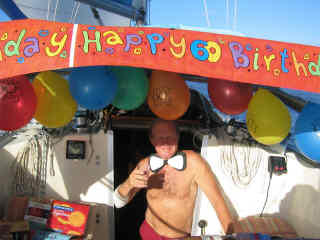

We tried fishing on our way across but were unable to match the spectacular success reported by a number of other boats; a lot of the gear we deployed is probably still being dragged around the ocean, unnoticed by the pelagic monsters that ripped it off the reel!
With just the two of us onboard, ensuring adequate sleep was one of the most important factors in our crossing. We started out with a three-hour system, but went quickly to four. Several days later Liz suggested that we should try five-hour watches at night and this really worked for us as it allowed time for some proper joined-up sleep. Our system was: EJ 2000 – 0100; DJ 0100 – 0600; EJ 0600 – 1000; DJ 1000 – 1400; EJ 1400 – 1700; DJ 1700 – 2000 (1400 to 2000: Flexible, to allow for radio schedule & ad hoc relaxation, depending on need).
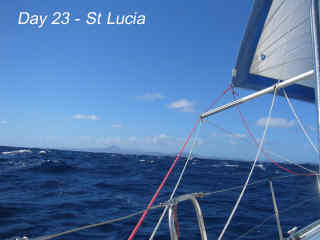 Like many others, we usually run a dry boat at sea. However, for the Atlantic crossing we took several half-bottles of champagne to celebrate significant waypoints, for example, the first 1000 miles, halfway, my birthday etc. Also, before leaving Fowey a good friend gave us some tins of liqueur cake and we opened one each Sunday afternoon. Today we recall these little celebrations with great fondness; they certainly enhanced our quality of life on passage and provided that delicious sense of anticipation that’s all too rare ashore.
Like many others, we usually run a dry boat at sea. However, for the Atlantic crossing we took several half-bottles of champagne to celebrate significant waypoints, for example, the first 1000 miles, halfway, my birthday etc. Also, before leaving Fowey a good friend gave us some tins of liqueur cake and we opened one each Sunday afternoon. Today we recall these little celebrations with great fondness; they certainly enhanced our quality of life on passage and provided that delicious sense of anticipation that’s all too rare ashore.We had our share of incidents on passage and I’m pleased to say that I learned a lot about life at sea in a small boat from each of them! 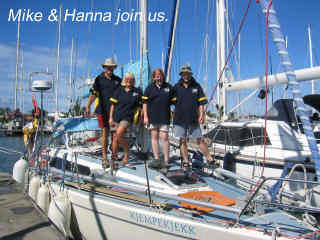 The most alarming and potentially disastrous occurrence was when I was nearly lost overboard when working on the foredeck whilst stupidly not wearing a life jacket or harness. In fine weather and not much wind, I’d been attending to the genoa tack and had just turned to make my way back aft when a sudden puff of breeze caught the erstwhile gently flapping genoa which then pushed me off balance from behind and over the side I went. Somehow one leg caught in the lower guard wire and while I was hanging upside down below the starboard bow, slowly slipping into the sea, Liz was able to come quickly forward and help me get back on board. There is no way I could have done it on my own and the crush wound caused by the wire lasted for many months.
The most alarming and potentially disastrous occurrence was when I was nearly lost overboard when working on the foredeck whilst stupidly not wearing a life jacket or harness. In fine weather and not much wind, I’d been attending to the genoa tack and had just turned to make my way back aft when a sudden puff of breeze caught the erstwhile gently flapping genoa which then pushed me off balance from behind and over the side I went. Somehow one leg caught in the lower guard wire and while I was hanging upside down below the starboard bow, slowly slipping into the sea, Liz was able to come quickly forward and help me get back on board. There is no way I could have done it on my own and the crush wound caused by the wire lasted for many months.
 The most alarming and potentially disastrous occurrence was when I was nearly lost overboard when working on the foredeck whilst stupidly not wearing a life jacket or harness. In fine weather and not much wind, I’d been attending to the genoa tack and had just turned to make my way back aft when a sudden puff of breeze caught the erstwhile gently flapping genoa which then pushed me off balance from behind and over the side I went. Somehow one leg caught in the lower guard wire and while I was hanging upside down below the starboard bow, slowly slipping into the sea, Liz was able to come quickly forward and help me get back on board. There is no way I could have done it on my own and the crush wound caused by the wire lasted for many months.
The most alarming and potentially disastrous occurrence was when I was nearly lost overboard when working on the foredeck whilst stupidly not wearing a life jacket or harness. In fine weather and not much wind, I’d been attending to the genoa tack and had just turned to make my way back aft when a sudden puff of breeze caught the erstwhile gently flapping genoa which then pushed me off balance from behind and over the side I went. Somehow one leg caught in the lower guard wire and while I was hanging upside down below the starboard bow, slowly slipping into the sea, Liz was able to come quickly forward and help me get back on board. There is no way I could have done it on my own and the crush wound caused by the wire lasted for many months. Dawn on the 23rd day out from Las Palmas and the high ground of St Lucia was there on the port bow, just where it should be. We had 15 to 18 knots of ENE trade behind us and we made it into Rodney bay by lunchtime to the most magnificent reception. 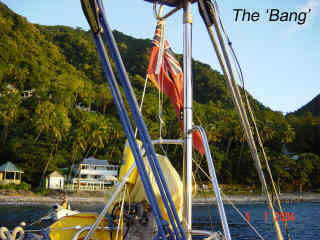 As we motored in through the cut, diners in waterside restaurants and bars stood and applauded us, lots of people helped us to tie up, there were gifts of fruit and rum punch and friends we hadn’t seen for weeks. Truly wonderful!
As we motored in through the cut, diners in waterside restaurants and bars stood and applauded us, lots of people helped us to tie up, there were gifts of fruit and rum punch and friends we hadn’t seen for weeks. Truly wonderful!
 As we motored in through the cut, diners in waterside restaurants and bars stood and applauded us, lots of people helped us to tie up, there were gifts of fruit and rum punch and friends we hadn’t seen for weeks. Truly wonderful!
As we motored in through the cut, diners in waterside restaurants and bars stood and applauded us, lots of people helped us to tie up, there were gifts of fruit and rum punch and friends we hadn’t seen for weeks. Truly wonderful!St Lucia, December 20th and true to their word Mike and Hannah flew in from UK via somewhere in Canada to join us for two weeks. We’d transformed the aft cabin from its role as a general store, chandlery and workshop to a cosy place to sleep and they settled in like veterans. We toured St Lucia, enjoyed a great beach BBQ on Christmas Day and took KJ over to Martinique for a few days. Back at Rodney Bay, we had a super New Year party on the beach; a couple of minutes before midnight Mike & Hannah surprised us by announcing their engagement and right on cue, fireworks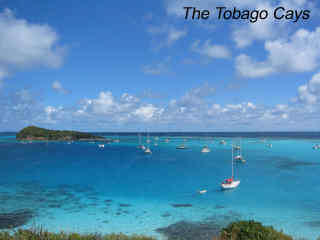

from nearby hotels lit up the sky! It was a really great time for us all and we were truly sad when they had to return home to the English winter. They had much to do having just moved house and Mike had a new job to get stuck into.
Jan 4 2004: Kjempekjekk headed south, taking us first to Petit Piton on the south-western coast of St Lucia. A lovely anchorage, although it was a bit rolly in the gentle northerly swell. We stayed three days, swimming and strolling ashore in this beautiful, peaceful place. Had a very sociable dinner ashore one evening in ‘The Bang’, Lord Glenconnor’s restaurant. There were ten of us from three boats and Lord G turned up to chat to us; a most interesting character in his towelling dressing gown and wide-brimmed hat!
On Liz’s birthday, as a special treat we were up at 0600 and away 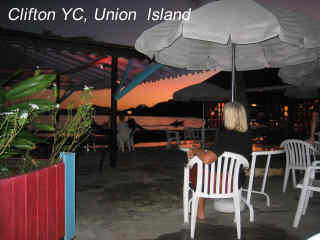 towards the south before sunrise. Brisk sailing saw us into Admiralty Bay, Bequia by 1530 where we intended to stay for no more than two days. However, we met several boats that we knew from our Atlantic crossing so we stayed more than a week before setting off on the short crossing to Mustique. Here, while trying to moor to a buoy in gusty conditions. I damaged my ribs. Quite painful so we chilled out for three days doing very little then returned to Bequia for a while to let things settle. By Jan 21st things were much better so we continued south to the Tobago Cays, a group of small, uninhabited islands protected from the full force of the Atlantic by Horseshoe Reef. As soon as we anchored Liz was in the crystal-clear water trying to chase a turtle that came along to inspect us.
towards the south before sunrise. Brisk sailing saw us into Admiralty Bay, Bequia by 1530 where we intended to stay for no more than two days. However, we met several boats that we knew from our Atlantic crossing so we stayed more than a week before setting off on the short crossing to Mustique. Here, while trying to moor to a buoy in gusty conditions. I damaged my ribs. Quite painful so we chilled out for three days doing very little then returned to Bequia for a while to let things settle. By Jan 21st things were much better so we continued south to the Tobago Cays, a group of small, uninhabited islands protected from the full force of the Atlantic by Horseshoe Reef. As soon as we anchored Liz was in the crystal-clear water trying to chase a turtle that came along to inspect us. 
 towards the south before sunrise. Brisk sailing saw us into Admiralty Bay, Bequia by 1530 where we intended to stay for no more than two days. However, we met several boats that we knew from our Atlantic crossing so we stayed more than a week before setting off on the short crossing to Mustique. Here, while trying to moor to a buoy in gusty conditions. I damaged my ribs. Quite painful so we chilled out for three days doing very little then returned to Bequia for a while to let things settle. By Jan 21st things were much better so we continued south to the Tobago Cays, a group of small, uninhabited islands protected from the full force of the Atlantic by Horseshoe Reef. As soon as we anchored Liz was in the crystal-clear water trying to chase a turtle that came along to inspect us.
towards the south before sunrise. Brisk sailing saw us into Admiralty Bay, Bequia by 1530 where we intended to stay for no more than two days. However, we met several boats that we knew from our Atlantic crossing so we stayed more than a week before setting off on the short crossing to Mustique. Here, while trying to moor to a buoy in gusty conditions. I damaged my ribs. Quite painful so we chilled out for three days doing very little then returned to Bequia for a while to let things settle. By Jan 21st things were much better so we continued south to the Tobago Cays, a group of small, uninhabited islands protected from the full force of the Atlantic by Horseshoe Reef. As soon as we anchored Liz was in the crystal-clear water trying to chase a turtle that came along to inspect us. 
That set the scene for the next few days; snorkelling on the reef, visiting nearby islands in the dinghy, sundowners and lobster suppers!
Union Island is little more than an hours sail from the Cays and we visited the capital, Clifton, for a couple of days – quite a busy little port with a good range of facilities from groceries to hardware stores, restaurants, and an internet cafe. After replenishing our stores, checking the weather and sending messages we went back to the Tobago Cays for a few days before creeping around the coast to Saltwhistle Bay on Mayreau. Didn’t stay there long – after three attempts getting the anchor to hold we went ashore to explore but soon noticed the boat moving off without us! We quickly got back aboard and headed north to Charlestown on Canouan; again, we didn’t like the look of the rolly anchorage so went back to Clifton.  This time we stayed five days and took the opportunity to visit nearby Palm Island. This is a privately owned holiday resort and the manager was pleased to arrange a guided tour for us; it looked delightful but very expensive!
This time we stayed five days and took the opportunity to visit nearby Palm Island. This is a privately owned holiday resort and the manager was pleased to arrange a guided tour for us; it looked delightful but very expensive!
 This time we stayed five days and took the opportunity to visit nearby Palm Island. This is a privately owned holiday resort and the manager was pleased to arrange a guided tour for us; it looked delightful but very expensive!
This time we stayed five days and took the opportunity to visit nearby Palm Island. This is a privately owned holiday resort and the manager was pleased to arrange a guided tour for us; it looked delightful but very expensive!Bad news on the HF radio net – during our last visits to Clifton and the Cays we anchored on both occasions near a catamaran called Joes Dog. We met the crew of three one evening – they were from Italy on a two-week holiday, going across to the island of Margarita off the Venezuelan coast. The day after leaving on their trip it was reported that they had been boarded by pirates who killed Bruno, the skipper, and ransacked the boat.
The last day of January and another early start southwards, to Prickly Bay at the southern end of Grenada. After an uneventful trip we arrived at around 1600 and anchored off the yacht club. A very pleasant place where we found a number of boats that we’d met before; some were taking part in Grenada Sailing Week and we became their cheer-leaders! During the next two days we had the good fortune to find True Blue Bay, just around the corner! There is a small marina here run by Horizon Yacht Charters and we arranged to bring Kjempekjekk around the following day. Facilities were excellent and as a surprise bonus we had access to the swimming pools that belong to the co-located small holiday hotel! HYC is run by Jacqui and James and we soon found out that Jacqui knows Fowey well – she did a sailing course with Fowey Cruising School and stayed on for a couple of years before heading off to the Caribbean.
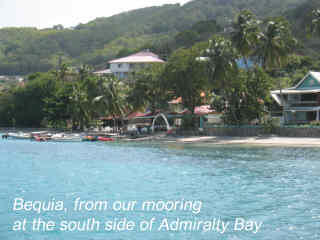 We enjoyed True Blue – no hassle, friendly people, good facilities, relaxing, but after nine days it was time to move on, so early in the morning of Thursday 12 February we reluctantly crept out of the bay. This was as far south as we’d go on this voyage and with very mixed feelings we headed northwards, first stop Tyrrel Bay in Carriacou. We sailed up the west coast of Grenada, skirted the exclusion zone around the live underwater volcano ‘Kick ‘em Jenny’ and entered Tyrrel Bay to anchor around 1600. Another coincidence here – during the evening we visited a floating bar in the bay and during conversation discovered that the lady running it knows Polruan well having once lived in a cottage there.
We enjoyed True Blue – no hassle, friendly people, good facilities, relaxing, but after nine days it was time to move on, so early in the morning of Thursday 12 February we reluctantly crept out of the bay. This was as far south as we’d go on this voyage and with very mixed feelings we headed northwards, first stop Tyrrel Bay in Carriacou. We sailed up the west coast of Grenada, skirted the exclusion zone around the live underwater volcano ‘Kick ‘em Jenny’ and entered Tyrrel Bay to anchor around 1600. Another coincidence here – during the evening we visited a floating bar in the bay and during conversation discovered that the lady running it knows Polruan well having once lived in a cottage there. We might have stayed longer in laid back, tranquil Carriacou but the weather forecast didn’t look too promising – NE winds increasing with gusts to 40kts – so we moved on quickly to Bequia. Here we secured to a buoy close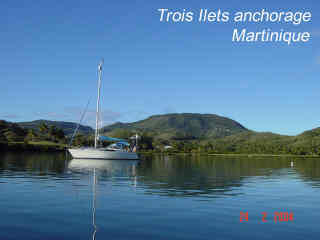 in by one of our favourite restaurants just hours before the squalls blew in.
in by one of our favourite restaurants just hours before the squalls blew in.
 in by one of our favourite restaurants just hours before the squalls blew in.
in by one of our favourite restaurants just hours before the squalls blew in. Bequia was a great place to visit, even for a third time, however when the squally winds abated in mid-February we were more or less ready to continue our journey northwards. The day before we left we were treated to a ring-side seat of the sail training ship Stavros Niarchos arriving for a 24-hour visit. She looked most impressive alongside the small dock at the head of Admiralty Bay, with a BIG red ensign streaming in the very fresh breeze and the presence of her many young people certainly helped bring down the average age of we itinerant sailors!
Luckily for us the wind had by now veered to the east so we enjoyed a fast reach in bright weather across the Bequia Channel up to St Vincent. We had planned to spend the night anchored off Chateaubelair, near the north of the island, but persistent hassle from so-called ‘boat boys’ persuaded us to leave before sunset for an overnight sail to St Lucia. In the event this turned out to be a good decision as we had a glorious sail over a large but easy sea in bright starlight; it was also the first night sail since our Atlantic crossing and a good opportunity to exercise our watch system.
To help celebrate St Lucia’s 25th year of independence, the marina at Rodney Bay offered two nights free berthing and 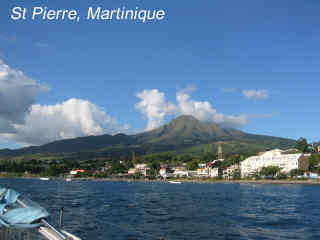 although it was very warm, we went in, stuck it out and did our bit! It was great to see the Royal Navy in the area – HMS Monmouth was just around the corner in Castries and RFA Wave Knight anchored just offshore in Rodney Bay. We replenished both the boat and ourselves to capacity and on Monday 23 February cleared customs and headed up to Martinique. Just before sunset we dropped anchor in Trois Ilets, just across the bay from Fort de France. This is a sheltered, very calm and peaceful haven, just yards offshore from a manicured golf course. However, we soon found out it was Mardi Gras time and were able to share the music for a couple of nights, well into the small hours. We just had to go ashore to see the carnival – a colourful, vigorous event with many aspects reminiscent of Fowey regatta week!
although it was very warm, we went in, stuck it out and did our bit! It was great to see the Royal Navy in the area – HMS Monmouth was just around the corner in Castries and RFA Wave Knight anchored just offshore in Rodney Bay. We replenished both the boat and ourselves to capacity and on Monday 23 February cleared customs and headed up to Martinique. Just before sunset we dropped anchor in Trois Ilets, just across the bay from Fort de France. This is a sheltered, very calm and peaceful haven, just yards offshore from a manicured golf course. However, we soon found out it was Mardi Gras time and were able to share the music for a couple of nights, well into the small hours. We just had to go ashore to see the carnival – a colourful, vigorous event with many aspects reminiscent of Fowey regatta week!
 although it was very warm, we went in, stuck it out and did our bit! It was great to see the Royal Navy in the area – HMS Monmouth was just around the corner in Castries and RFA Wave Knight anchored just offshore in Rodney Bay. We replenished both the boat and ourselves to capacity and on Monday 23 February cleared customs and headed up to Martinique. Just before sunset we dropped anchor in Trois Ilets, just across the bay from Fort de France. This is a sheltered, very calm and peaceful haven, just yards offshore from a manicured golf course. However, we soon found out it was Mardi Gras time and were able to share the music for a couple of nights, well into the small hours. We just had to go ashore to see the carnival – a colourful, vigorous event with many aspects reminiscent of Fowey regatta week!
although it was very warm, we went in, stuck it out and did our bit! It was great to see the Royal Navy in the area – HMS Monmouth was just around the corner in Castries and RFA Wave Knight anchored just offshore in Rodney Bay. We replenished both the boat and ourselves to capacity and on Monday 23 February cleared customs and headed up to Martinique. Just before sunset we dropped anchor in Trois Ilets, just across the bay from Fort de France. This is a sheltered, very calm and peaceful haven, just yards offshore from a manicured golf course. However, we soon found out it was Mardi Gras time and were able to share the music for a couple of nights, well into the small hours. We just had to go ashore to see the carnival – a colourful, vigorous event with many aspects reminiscent of Fowey regatta week! Our one-night stop stretched out to four days and with some reluctance we heaved our anchor out of the thick grey mud and eased away towards the town of St Pierre at the NW end of Martinique. We arrived the same evening and by dusk 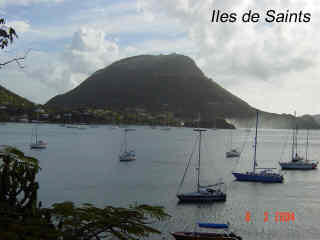 we were settled having taken the best part of an hour to get the anchor to hold in the hard-bottomed bay. The volcano behind the town last erupted in 1902, killing many thousands of people and sinking several ships at anchor in the bay. One of the two survivors was a convicted murderer and his cell is still there in the corner of the ruined prison. We spent a hot day here looking around the sights, visiting the museum and other places of interest. We would have stayed longer but the forecast wasn’t too good and when the wind started blowing onshore we decided to put to sea and sail overnight to Guadeloupe. Again, we were fortunate to enjoy a superb night sail and we got into Pointe a Pitre by noon the next day.
we were settled having taken the best part of an hour to get the anchor to hold in the hard-bottomed bay. The volcano behind the town last erupted in 1902, killing many thousands of people and sinking several ships at anchor in the bay. One of the two survivors was a convicted murderer and his cell is still there in the corner of the ruined prison. We spent a hot day here looking around the sights, visiting the museum and other places of interest. We would have stayed longer but the forecast wasn’t too good and when the wind started blowing onshore we decided to put to sea and sail overnight to Guadeloupe. Again, we were fortunate to enjoy a superb night sail and we got into Pointe a Pitre by noon the next day.
 we were settled having taken the best part of an hour to get the anchor to hold in the hard-bottomed bay. The volcano behind the town last erupted in 1902, killing many thousands of people and sinking several ships at anchor in the bay. One of the two survivors was a convicted murderer and his cell is still there in the corner of the ruined prison. We spent a hot day here looking around the sights, visiting the museum and other places of interest. We would have stayed longer but the forecast wasn’t too good and when the wind started blowing onshore we decided to put to sea and sail overnight to Guadeloupe. Again, we were fortunate to enjoy a superb night sail and we got into Pointe a Pitre by noon the next day.
we were settled having taken the best part of an hour to get the anchor to hold in the hard-bottomed bay. The volcano behind the town last erupted in 1902, killing many thousands of people and sinking several ships at anchor in the bay. One of the two survivors was a convicted murderer and his cell is still there in the corner of the ruined prison. We spent a hot day here looking around the sights, visiting the museum and other places of interest. We would have stayed longer but the forecast wasn’t too good and when the wind started blowing onshore we decided to put to sea and sail overnight to Guadeloupe. Again, we were fortunate to enjoy a superb night sail and we got into Pointe a Pitre by noon the next day.The forecast strong winds didn’t come up for another two days; during this time our marina berth was hot and airless and the little 12-volt fan that we’d fitted in Grenada came into it’s own. After completing some routine engine maintenance we hired a car for a few days and became tourists! Away from the heat and bustle of the main towns the island was fascinating with glorious coastal viewpoints, one of the best botanical gardens we’ve seen and a zoological park with forest canopy walkways.
By 6 March the strong, squally winds had moderated so we checked out of our marina berth and headed down to the Saints, a small group of islands to the south of Guadeloupe. We anchored in the lee of Ile Cabrit where it was quiet but prone to squally downdraughts; there was room for us to swing 360deg so there was no problem. In fact the only problem encountered here was when I speared my right eye on a wire stub-aerial. This happened on another boat at night and the 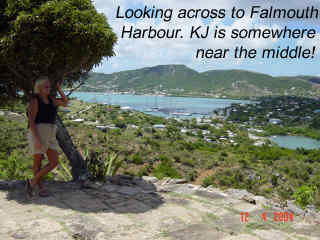 aerial was fixed low down on the pushpit, just above where our hosts had tied our dinghy painter! By the following morning we could see the eye was already infected and the gouged area was clearly visible so we motored across to the main island where we visited the pharmacy. From there we were directed to the nearby local doctor who promptly examined and treated the injury, prescribed medication and gave instruction on application. This wonderful doctor also arranged for the local fire brigade to take us to a retired eye surgeon living on the island in the event of any further problem. A most impressive service, especially on such a small island and we’re pleased to say the treatment was entirely successful.
aerial was fixed low down on the pushpit, just above where our hosts had tied our dinghy painter! By the following morning we could see the eye was already infected and the gouged area was clearly visible so we motored across to the main island where we visited the pharmacy. From there we were directed to the nearby local doctor who promptly examined and treated the injury, prescribed medication and gave instruction on application. This wonderful doctor also arranged for the local fire brigade to take us to a retired eye surgeon living on the island in the event of any further problem. A most impressive service, especially on such a small island and we’re pleased to say the treatment was entirely successful.
 aerial was fixed low down on the pushpit, just above where our hosts had tied our dinghy painter! By the following morning we could see the eye was already infected and the gouged area was clearly visible so we motored across to the main island where we visited the pharmacy. From there we were directed to the nearby local doctor who promptly examined and treated the injury, prescribed medication and gave instruction on application. This wonderful doctor also arranged for the local fire brigade to take us to a retired eye surgeon living on the island in the event of any further problem. A most impressive service, especially on such a small island and we’re pleased to say the treatment was entirely successful.
aerial was fixed low down on the pushpit, just above where our hosts had tied our dinghy painter! By the following morning we could see the eye was already infected and the gouged area was clearly visible so we motored across to the main island where we visited the pharmacy. From there we were directed to the nearby local doctor who promptly examined and treated the injury, prescribed medication and gave instruction on application. This wonderful doctor also arranged for the local fire brigade to take us to a retired eye surgeon living on the island in the event of any further problem. A most impressive service, especially on such a small island and we’re pleased to say the treatment was entirely successful.After five days in the Saints it was time to head north once more, this time to Deshaies at the NW tip of Martinique. Just one night here as we’d already seen some of the small town during our three-day tourist period and the forecast was again talking about increasing winds and a developing northerly swell. So the following morning we stuck our bows round the north corner of the bay into a bright and blustery E5 – 6 and started out well reefed on another fine reach up to Antigua. We arrived in Jolly Harbour at 1630 to find customs and immigration closed so we tied up to their dock and enjoyed a free night alongside until they turned up at around 0930 next morning. Formalities were thorough but friendly and we were soon alongside a berth in the marina.
The following day we were pleasantly surprised to be visited by a couple who had just arrived on a week’s holiday. They were walking by and were surprised to see ‘Fowey’ on KJs stern; they 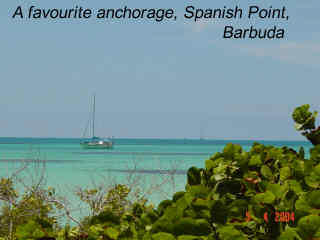 soon recognised us – their boat is kept just two places astern of our mooring in Fowey!
soon recognised us – their boat is kept just two places astern of our mooring in Fowey!
 soon recognised us – their boat is kept just two places astern of our mooring in Fowey!
soon recognised us – their boat is kept just two places astern of our mooring in Fowey!Several days later we had moved around to Falmouth Harbour, on the south coast of Antigua, again waiting for blustery, squally weather to blow over. Plenty to see and do here, just a short walk from English Harbour and Nelson’s Dockyard and there is a good bus service. The anchorages that we planned to visit on the east side of the island are much easier and safer in settled weather so for the time being we were content to wait a while.
We enjoyed Antigua; while we were based in Falmouth 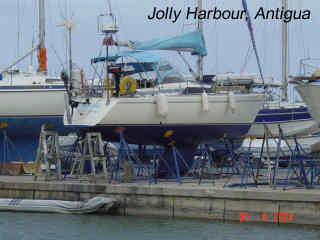 we got a spectacular close-up view of the classic sailing fleet at sea, including three J-boats. There are many superb anchorages out around the reefs and we had ample opportunity to develop our pilotage skills. A favourite place was Barbuda, around 27 miles north; the anchorage at the south end of the island was in the clearest water we’ve ever seen, but we had to work our way in carefully through a reef and numerous coral heads; for a while we even had daily visits from a mother and baby dolphin.
we got a spectacular close-up view of the classic sailing fleet at sea, including three J-boats. There are many superb anchorages out around the reefs and we had ample opportunity to develop our pilotage skills. A favourite place was Barbuda, around 27 miles north; the anchorage at the south end of the island was in the clearest water we’ve ever seen, but we had to work our way in carefully through a reef and numerous coral heads; for a while we even had daily visits from a mother and baby dolphin.
 we got a spectacular close-up view of the classic sailing fleet at sea, including three J-boats. There are many superb anchorages out around the reefs and we had ample opportunity to develop our pilotage skills. A favourite place was Barbuda, around 27 miles north; the anchorage at the south end of the island was in the clearest water we’ve ever seen, but we had to work our way in carefully through a reef and numerous coral heads; for a while we even had daily visits from a mother and baby dolphin.
we got a spectacular close-up view of the classic sailing fleet at sea, including three J-boats. There are many superb anchorages out around the reefs and we had ample opportunity to develop our pilotage skills. A favourite place was Barbuda, around 27 miles north; the anchorage at the south end of the island was in the clearest water we’ve ever seen, but we had to work our way in carefully through a reef and numerous coral heads; for a while we even had daily visits from a mother and baby dolphin. Back in Antigua in early May we splashed out and took a helicopter tour over to Monserrat to see the volcano and surrounding area. Fortunately the weather stayed fair so we got superb views of the massive devastation.
The week before we sailed to Bermuda, Kjempekjekk was hauled out for a couple of days to allow us to clean the bottom, renew the anti-fouling and generally check beneath the water line. All was well and two days later we were back in the water. The weather during this period (late April/early May) was more like the West Country in March (but warmer), with strong winds and torrential rain. Fortunately the forecast indicated some moderation so we were confident that we could clear away to the north without too much trouble.
The 980-mile run up to Bermuda was uneventful;  we beat into a brisk NE breeze for most of the trip, which in our heavily laden state kept our port rail under water for much of the first six days. A minor down-side of this was that the heads (on the starboard side) had to be tended manually with salt water – rather a hit or miss event at night! Five days in Bermuda is not enough really. It’s a beautiful place and between preparing ourselves and the boat for the Atlantic, we managed to see enough to tempt us back one day. Too soon the day came to leave St Georges and we headed out through the cut, eastwards to the Azores.
we beat into a brisk NE breeze for most of the trip, which in our heavily laden state kept our port rail under water for much of the first six days. A minor down-side of this was that the heads (on the starboard side) had to be tended manually with salt water – rather a hit or miss event at night! Five days in Bermuda is not enough really. It’s a beautiful place and between preparing ourselves and the boat for the Atlantic, we managed to see enough to tempt us back one day. Too soon the day came to leave St Georges and we headed out through the cut, eastwards to the Azores.
 we beat into a brisk NE breeze for most of the trip, which in our heavily laden state kept our port rail under water for much of the first six days. A minor down-side of this was that the heads (on the starboard side) had to be tended manually with salt water – rather a hit or miss event at night! Five days in Bermuda is not enough really. It’s a beautiful place and between preparing ourselves and the boat for the Atlantic, we managed to see enough to tempt us back one day. Too soon the day came to leave St Georges and we headed out through the cut, eastwards to the Azores.
we beat into a brisk NE breeze for most of the trip, which in our heavily laden state kept our port rail under water for much of the first six days. A minor down-side of this was that the heads (on the starboard side) had to be tended manually with salt water – rather a hit or miss event at night! Five days in Bermuda is not enough really. It’s a beautiful place and between preparing ourselves and the boat for the Atlantic, we managed to see enough to tempt us back one day. Too soon the day came to leave St Georges and we headed out through the cut, eastwards to the Azores.Our passage from Bermuda to Horta took just on 14 days; it’s around 1800 miles so that’s not bad for a 33-foot boat. The first few days were virtually calm so we motored, however the wind then filled in steadily, until 28/29 May when we encountered gale conditions, gusting to over 48 knots. It didn’t last too long though, so by the following day we were sailing well under a triple-reefed main and in due course, a full genoa. For four of the last five days to Horta, conditions were superb; we enjoyed uninterrupted beam-reach sailing and a relatively steady sea, achieving an average 24-hour run-rate (for the four days) of 157 miles.
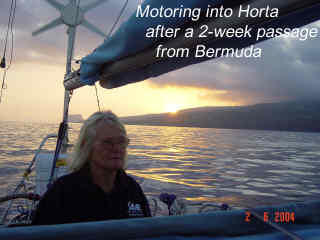 The Azores proved to be a most interesting group of islands. We very much liked Horta, on Faial, but Terceira, 70 miles to the ESE, was a delight. They had recently completed a new marina (uncharted!) so there was plenty of space, the staff were helpful and friendly and the facilities were excellent. By contrast our arrival in Ponta Delgada came as a bit of a surprise. The non-uniformed people here are without doubt as friendly and helpful as anyone we’ve met, however the various maritime departments, in particular the police, made things heavy going at times and the bureaucracy was the worst we’d encountered in the whole trip. We had to visit many offices, including a trip to the other end of town to pay our ‘Light Tax’ (€2.40!)
The Azores proved to be a most interesting group of islands. We very much liked Horta, on Faial, but Terceira, 70 miles to the ESE, was a delight. They had recently completed a new marina (uncharted!) so there was plenty of space, the staff were helpful and friendly and the facilities were excellent. By contrast our arrival in Ponta Delgada came as a bit of a surprise. The non-uniformed people here are without doubt as friendly and helpful as anyone we’ve met, however the various maritime departments, in particular the police, made things heavy going at times and the bureaucracy was the worst we’d encountered in the whole trip. We had to visit many offices, including a trip to the other end of town to pay our ‘Light Tax’ (€2.40!)‘We’re now preparing ourselves and the boat for departure and our plan is to head northeast to Plymouth where ARC Europe finishes in Mayflower Marina. We expect to arrive there around 1 July. Seven other boats are headed the same way so we’ll probably spend a couple of days there saying farewells etc before heading around to Polruan and the end of this cruise.’
We sent this message to family and friends on 18 June 2004.
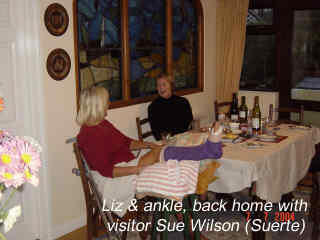 Two days later Liz fell awkwardly on the steps of the market at Punta Delgada, dislocating her ankle and breaking both tibia and fibula. A day later, after she had been prepared by the local hospital, we flew back home, courtesy of our insurers, where she was immediately taken into hospital at Plymouth. After a year she is now fully recovered, however if you are interested and she lets you get close enough you can still see the scar and screws holding things in place.
Two days later Liz fell awkwardly on the steps of the market at Punta Delgada, dislocating her ankle and breaking both tibia and fibula. A day later, after she had been prepared by the local hospital, we flew back home, courtesy of our insurers, where she was immediately taken into hospital at Plymouth. After a year she is now fully recovered, however if you are interested and she lets you get close enough you can still see the scar and screws holding things in place. This ended Kjempekjekk’s 2003/2004 voyage as far as we were concerned. Luckily for us, friends flew out later to bring the boat back to Fowey. Today we are getting ready to sail to France and/or Spain this summer before completing preparations during the coming winter for what we hope will be another extended trip ……
